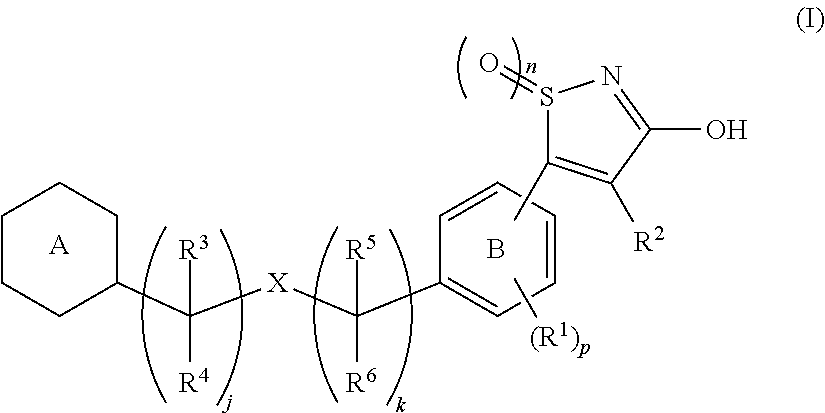3-hydroxy-5-arylisothiazole derivative
a technology of arylisothiazole and derivative, applied in the direction of biocide, drug composition, metabolic disorder, etc., can solve the problems of ineffectiveness, side effects, abrupt increase, etc., and achieve the effect of accelerating insulin secretion, lowering blood glucose level, and advantageous solubility
- Summary
- Abstract
- Description
- Claims
- Application Information
AI Technical Summary
Benefits of technology
Problems solved by technology
Method used
Image
Examples
preparation example
[0680]Hereinafter, Examples of the pharmaceutical compositions of the present invention are described.
[0681]
Preparation Example 1tabletsCompound of Example 2100gLactose137gMicrocrystalline cellulose30gHydroxypropylcellulose15gSodium carboxymethyl starch15gMagnesium stearate3g
[0682]The above components are weighed and then are uniformly mixed. The mixture is formed into tablets to have a weight of 150 mg.
[0683]
Preparation Example 2film coatingHydroxypropylmethylcellulose9 gMacrogol 60001 gTitanium oxide2 g
[0684]The above components are weighed. Subsequently, hydroxypropylmethylcellulose and macrogol 6000 are dissolved into water to disperse titanium oxide. The resultant liquid is film coated on 300 g of the tablets of Preparation Example 1 to obtain film-coated tablets.
[0685]
Preparation Example 3capsulesCompound of Example 650 gLactose435 g Magnesium stearate15 g
[0686]The above components are weighed and then are uniformly mixed. The mixture is filled into adequate hard capsules by a...
reference example 1
Synthesis of Ethyl 3-(4-hydroxyphenyl)Propiolate
[0695]According to a method described in [WO 2008 / 066131 pamphlet, (Reference Example 1)], the subject compound (10.5 g) was obtained from 4-iodophenol (33.0 g) as a light yellow solid.
reference example 2
Synthesis of 3-(2,6-dimethylphenyl)Benzyl Chloride
[0696]To 3-(2,6-dimethylphenyl)benzyl alcohol (51.9 g) synthesized according to a method described in [WO 2004 / 041266 pamphlet, (Reference Example 200)], thionyl chloride (130 mL) was gradually added and the resultant reaction mixture was heated under reflux for 3 hours. The reaction mixture was gradually dropped into ice-cooled methanol (inside temperature: 15° C. or less) and the resultant reaction mixture was adjusted to around pH 8 with saturated sodium bicarbonate water, followed by extracting the reaction mixture with ethyl acetate. The resultant organic phase was washed sequentially with a saturated aqueous sodium bicarbonate, water, and saturated saline, and was dried over anhydrous sodium sulfate. From the organic phase, the solvent was distilled off under reduced pressure and the resultant residue was purified by silica gel column chromatography (eluate: n-hexane:ethyl acetate=70:1) to obtain the subject compound (36.1 g) a...
PUM
| Property | Measurement | Unit |
|---|---|---|
| RI | aaaaa | aaaaa |
| temperature | aaaaa | aaaaa |
| temperature | aaaaa | aaaaa |
Abstract
Description
Claims
Application Information
 Login to View More
Login to View More - R&D
- Intellectual Property
- Life Sciences
- Materials
- Tech Scout
- Unparalleled Data Quality
- Higher Quality Content
- 60% Fewer Hallucinations
Browse by: Latest US Patents, China's latest patents, Technical Efficacy Thesaurus, Application Domain, Technology Topic, Popular Technical Reports.
© 2025 PatSnap. All rights reserved.Legal|Privacy policy|Modern Slavery Act Transparency Statement|Sitemap|About US| Contact US: help@patsnap.com



